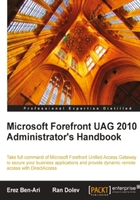
In this chapter, we will discuss the required steps to prepare and install UAG. We will discuss the critical settings you will need to configure before the installation and how to prepare the server for it, and then we will go through the setup process step-by-step. Finally, we will review how to verify that the installation went successfully and learn how to handle some common issues you might face.
Compared to many other software products, installing UAG is a simple process. It does not require a lot of of pre-requisite components to be installed or dozens of decisions to be made in the middle of the process. It does, however, require proper planning. We have already discussed how to plan your deployment and we will delve into more detail shortly.
The installation procedure is almost completely automatic. Once run, it will install and configure TMG, the firewall that is the forefront protection for UAG, and then install UAG itself. The installation also installs and configures other components and roles, such as AJAX, Remote Desktop Gateway, Network Load Balancing, Active Directory Lightweight Directory Services (also known as ADLDS), Network Policy Server, and a few others. The installation itself rarely fails, though it does take a significant amount of time—typically half an hour, but in some cases, as much as two full hours. Once it has completed, the next step is running the Getting Started Wizard, which is also pretty simple in itself. The Getting Started Wizard will configure some basic options that UAG needs, such as the networking and routing configuration and the server topology.
At the time of writing, two updates and one service pack have been issued for UAG, but further updates or Service Packs may be available later on. If you have purchased the product recently, it is likely that the ISO image file or DVD that you have already contains the service pack 'streamlined' into the installation, so there's little to worry about. If you purchased your server as an appliance, then it's also likely that it already is updated, but in either case, it's a good idea to verify this. In case a later update or Service Pack has been released, you may need to apply them after the installation. In this case, we recommend not waiting, but performing the update as soon as you can, following completion of the installation itself, or after completing the Getting Started Wizard. The reason for this is because updates sometimes affect the process of published application generation and templates, so it would be preferable to have the latest settings available while you publish those applications. Otherwise, you might find later that you need to recreate some applications after applying updates. Another good idea is to backup the server before applying any updates or service packs, or take a Virtual Machine Snapshot, if you are using a VM. We will discuss the process of applying updates or service packs later in this chapter.